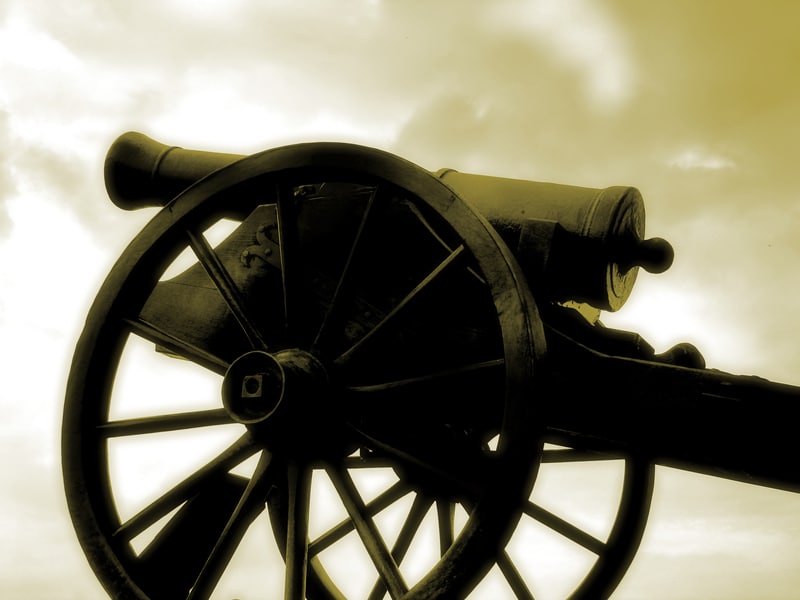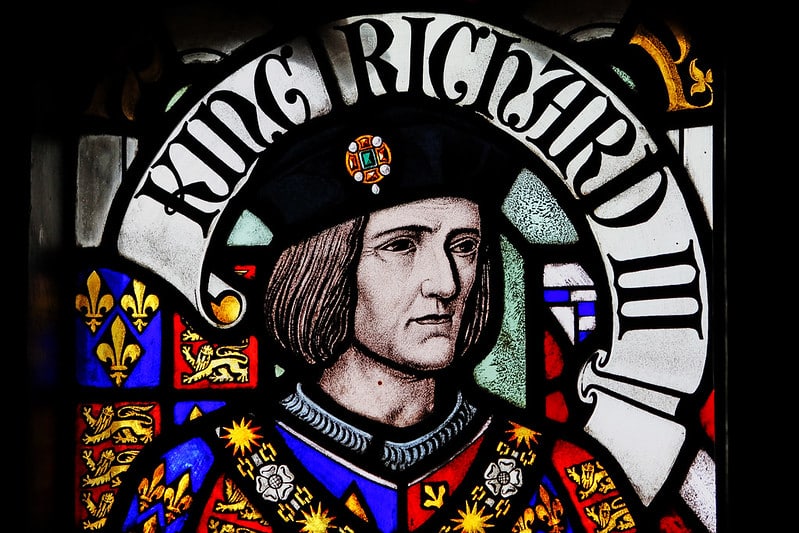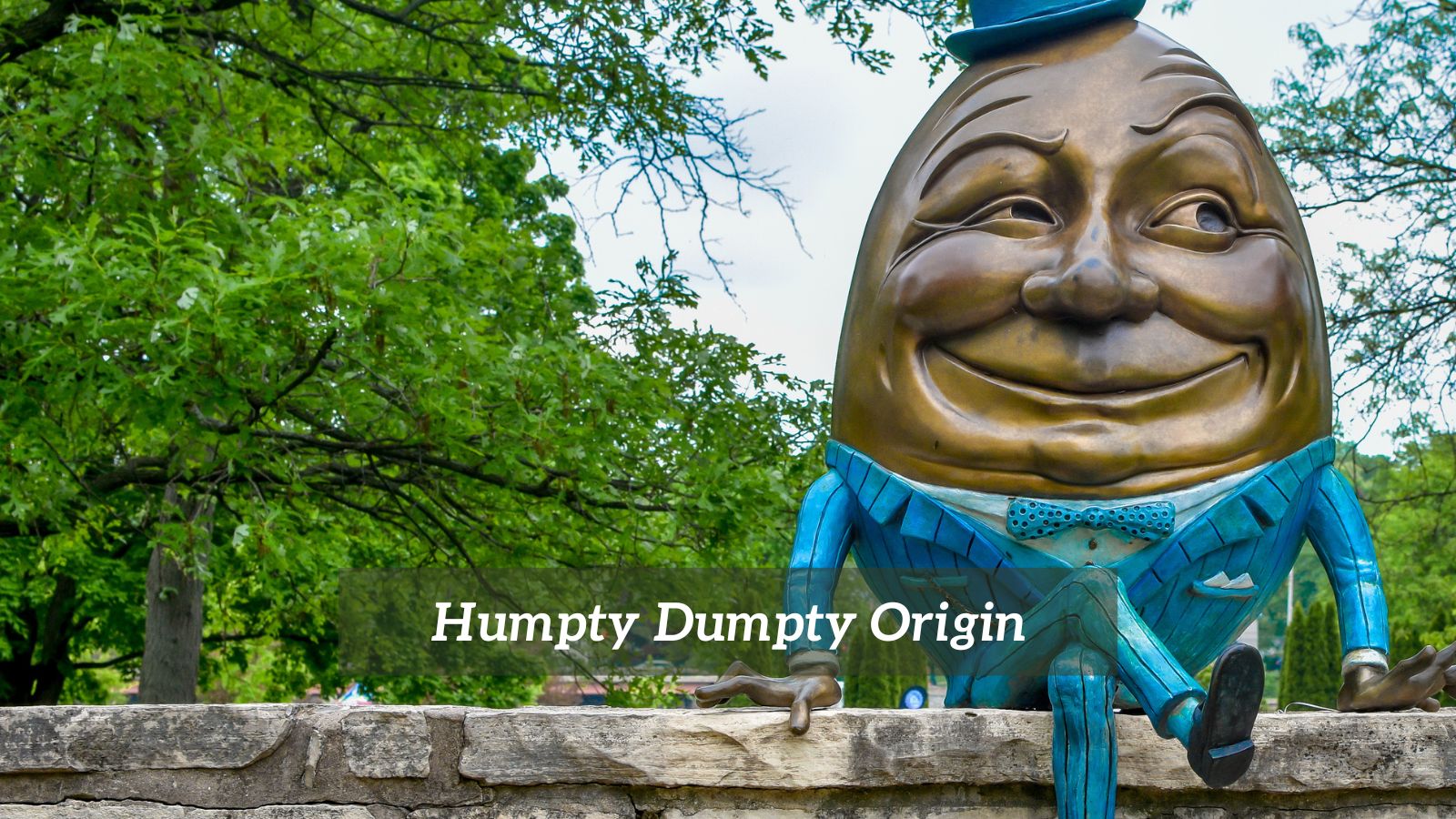
Today we’ll explore the origin of perhaps one of the most famous nursery rhymes in the English language—Humpty Dumpty.
Many theories have been posited throughout the years, and each one has its own merit. Although there isn’t one that can be singled out as the ultimate and correct one, they are all fascinating nonetheless.
So, let’s dive into the origins of Humpty Dumpty, see what we can learn, and debunk some theories along the way.
The main theories are:
- Humpty Dumpty was a cannon
- It refers to King Richard III or Cardinal Wolsley
- It is a derogatory term for a short, stout person who is clumsy
- Humpty Dumpty is an egg (a la Lewis Carroll)
Humpty Dumpty Origin
The Original Rhyme
The earliest version of the Humpty Dumpty rhyme dated back to 1797 and was published by Samuel Arnold in his book Juvenile Amusements. The rhyme reads:
| Oldest known version: 1797 | Modern version: mid-20th century |
|---|---|
| Humpty Dumpty sat on a wall, | Humpty Dumpty sat on a wall, |
| Humpty Dumpty had a great fall. | Humpty Dumpty had a great fall. |
| Four-score Men and Four-score more, | All the king’s horses and all the king’s men |
| Could not make Humpty Dumpty where he was before. | Couldn’t put Humpty together again |
In British English, a score is 20 men; thus, a four score is eighty men. So, 160 men couldn’t put Humpty Dumpty back together again. This is probably a hyperbole to illustrate that if something is broken, it can never be put together perfectly again.
Was Humpty Dumpty a Cannon?
Unfortunately, the reference to Humpty Dumpty being a cannon is not accurate. The rhyme is often used as speculative historical evidence for a battle during the English Civil War in 1648. Royalist forces occupied Colchester, and the Parliamentary army was attacking them.
Apparently, a lone gunner managed to somehow get a cannon (colloquially known as Humpty Dumpty) to the top of the tower of St Mary at the Walls (sat on the wall) and fired at the opposing forces.
The Parliamentary army focussed their attack on that particular spot. It blew the top of the tower off, and the gunner and cannon had a great fall. Unfortunately, the Royalist army (all the king’s men) could not make Humpty Dumpty where he was before.
Jack Albert put forward this claim in his 2010 book Pop Goes the Weasel: The Secret Meanings of Nursery Rhymes. The BS Historian has written a fantastic piece debunking this myth.
Was Humpty Dumpty an Actual Person?
Here we have three sub-theories to explore:
i. it refers to King Richard III,
ii. it relates to the downfall of Cardinal Wolsley,
iii. or it refers to an alcoholic drink or clumsy person.
King Richard III died in 1485 in the Battle of Bosworth. Speculation states the king’s horse was called ‘Wall’ of all things—maybe it was a massive horse? The king fell off his horse (‘Wall’), but his men could not save him.
Richard III had scoliosis, and the king was described as hunchbacked. Whether this was politically motivated or true, we won’t know for sure.
Punch Or the London Charivari in 1842 jokingly published that the rhyme was a metaphor for the fall of Cardinal Thomas Wolsley. The illustration of Cardinal Wolsley shows the cardinal as a short, fat person sitting on a wall resembling an egg.
The cardinal failed to secure the annulment of King Henry VIII’s marriage to Catherine of Aragon so that the king could marry Anne Boleyn. Wolsley’s failure led to his arrest, and he fell out of favor with the king and lost all his status.
King Henry VIII also took credit for many of Wolsley’s building projects. He even took away the tomb Wolsley planned for his burial at Windsor.
A Derogatory Term for Short People, or a Drink
Humpty Dumpty is defined as follows in Francis Grose’s Classical Dictionary of the Vulgar Tongue: “a little humpty dumpty man or woman, a short clumsey [sic] person of either sex, also ale boiled with brandy.”
If someone became drunk on a humpty dumpty drink, they’d fall off a wall or fall over while walking.
Was Humpty Dumpty an Egg?
Let’s start with the portrayal most of us recall from childhood: Humpty Dumpty was an egg. Lewis Carroll’s follow-up novel, Through the Looking Glass, was published in 1871.
Alice meets Humpty Dumpty in Chapter 6 and remarks that he looks “exactly like an egg,” which Humpty finds “very provoking.”
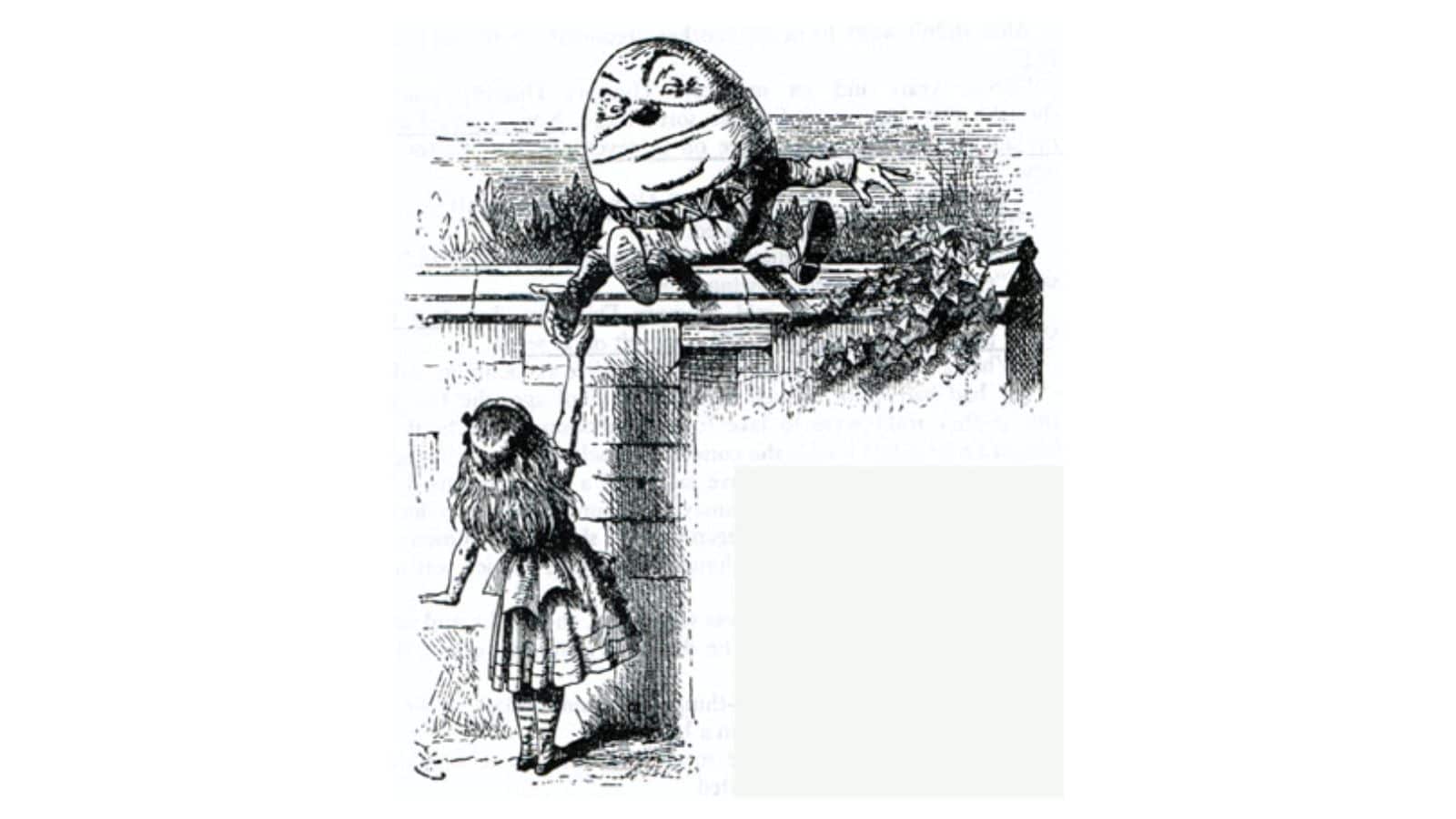
Humpty Dumpty—The Original Song
The first accompaniment to the nursery rhyme was published around 1873. James William Elliott composed the accompaniments to the nursery rhymes. The illustrations were engraved by the Dalziel brothers, George and Edward.
Interestingly, the image accompanying the sheet music shows a boyish figure with an egg for a head, cracked open and its contents pouring out while a frog looks on hopelessly.
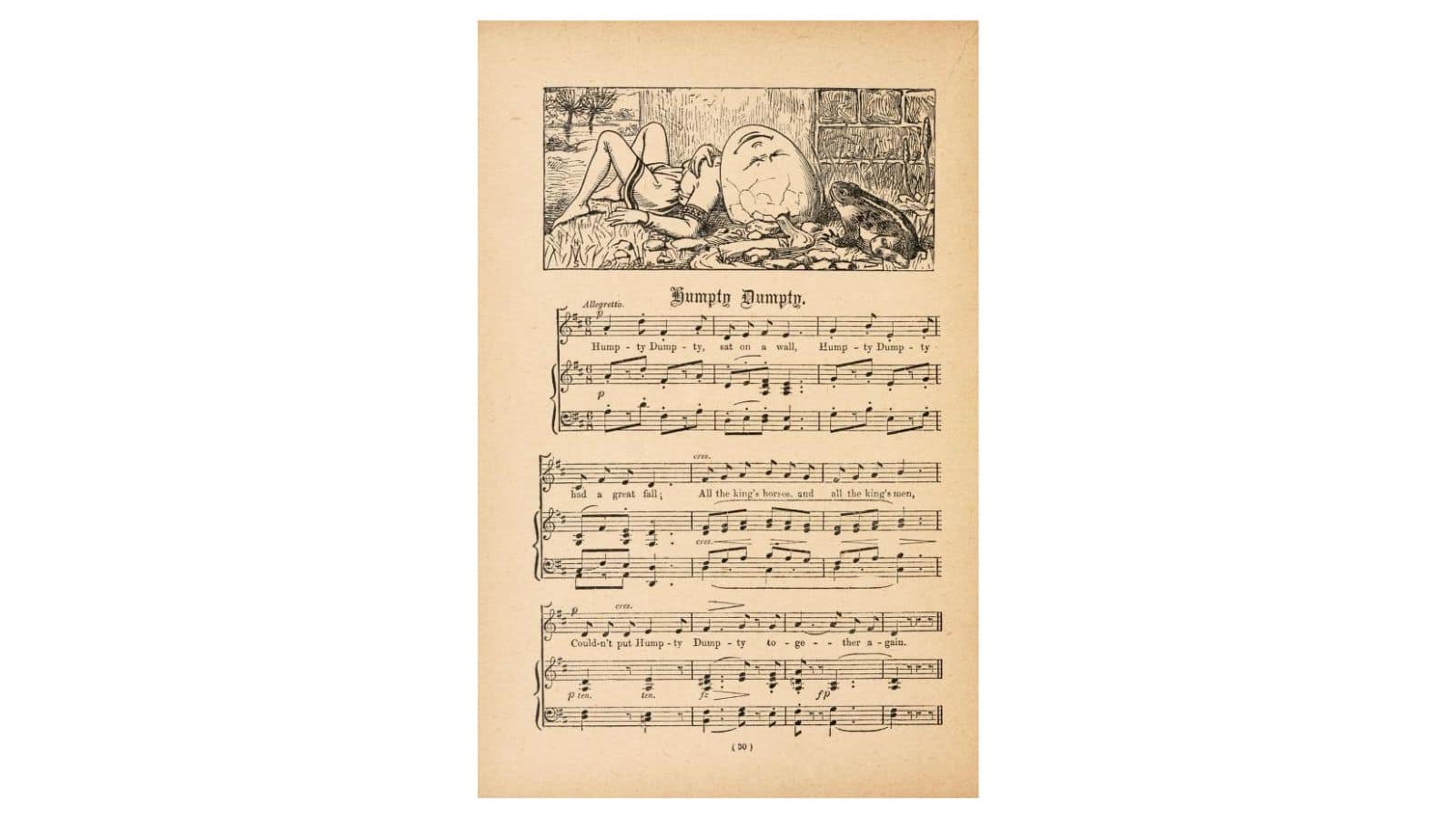
The second published version, dating from 1877, with sheet music for Humpty Dumpty, is found in Walter Crane’s Mother Goose’s Nursery Rhymes.
It’s interesting to note that Crane’s illustration shows a boy instead of an egg, as seen in the drawing by Sir John Tenniel, and differs from the Dalziel Brothers’ engraving.
The melody is also much more straightforward—the song is presented in C major, the large fifth leaps are reduced to thirds in the opening, and the tune follows a more natural, stepwise motion.
Unfortunately, we do not know who composed the melody and provided the accompaniment.
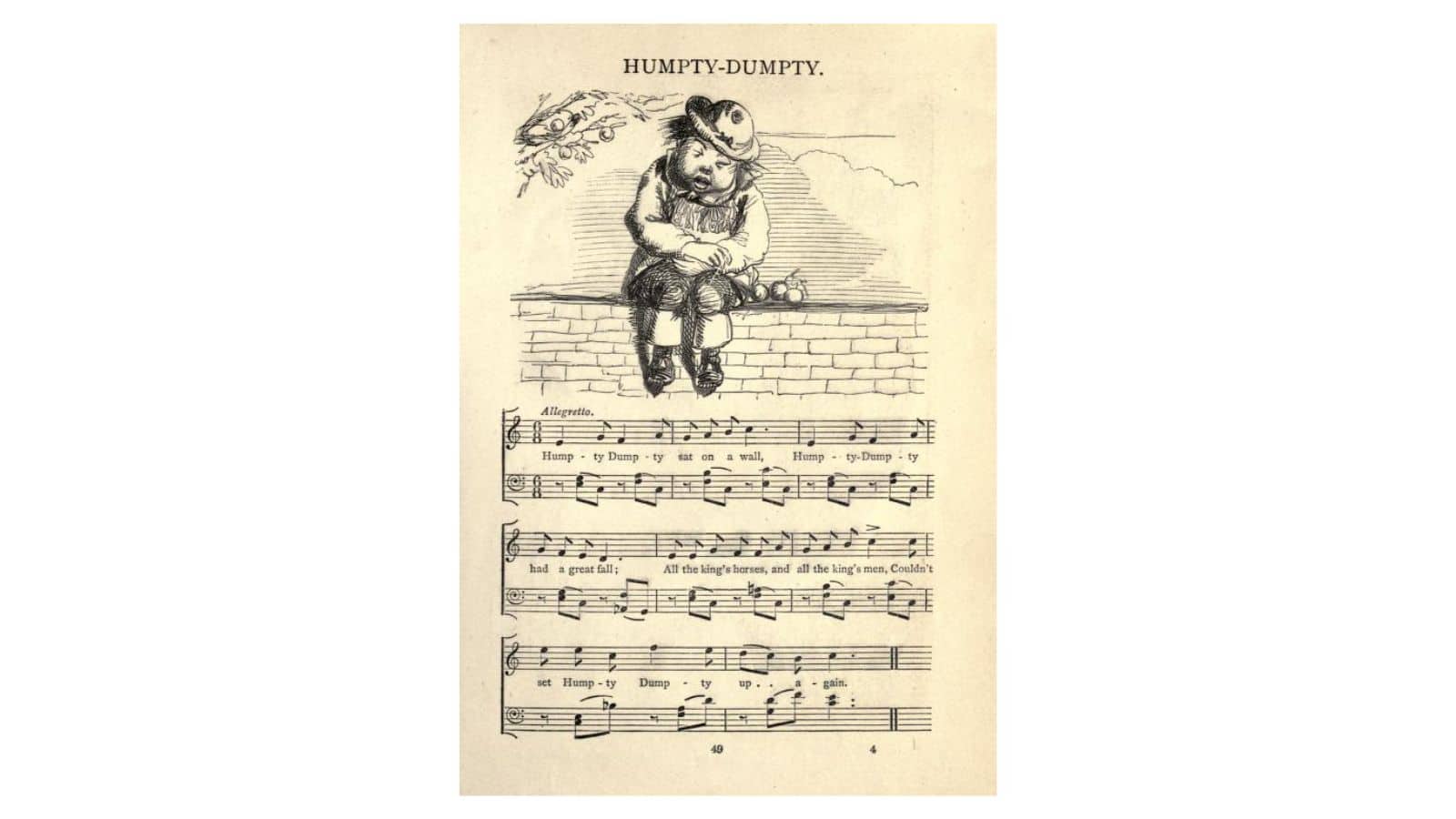
Conclusion
We may not know the true origins of Humpty Dumpty, but a shortage of theories; there is not. Often nursery rhymes are purely made-up entertainment for small children, and there is no other explanation required.
Humpty Dumpty most probably falls in the latter class. Still, as a parting thought, we could interpret Humpty Dumpty is a moral lesson about humility and a warning against vanity and arrogance.

